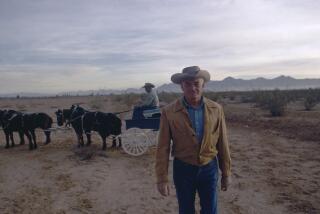Television review: ‘How the States Got Their Shapes’
I am a map lover from way back. As a child, I would hand-copy the continents from an atlas, and even now I can spend too much time on Google Maps seeing how things fit together, or geotagging old photos, pinpointing just where in the world I stood to take them. This is just by way of saying that I am a person who would be more than usually interested in watching something called “How the States Got Their Shapes.”
Such is the title of a new, brief series premiering Tuesday on the History channel; it follows and shares a title with a 2010 special, which itself shared the name of a book by Mark Stein, who appears here as a talking head. It only partially delivers on its titular premise; much of it has little or nothing to do, except in an associative way, with the shaping of states. But it is a breezy watch, with plenty of pretty pictures, taken all over this land, and enough Fascinating Facts for the viewer to feel he is not being merely entertained.
Hosted on the trot by Brian Unger (NPR commentator, early “Daily Show” contributor), the show is more whimsical than Stein’s book, with Unger engaging various experts and citizens in what is meant to be and generally is amusing repartee. Passersby are asked to name the states that border the Mississippi or the railroads of Monopoly, or to judge whether Maine’s water really is the best around. (According to people from Maine, it is.)
We learn that Nevada’s pointy bottom was an upshot of Congress punishing pre-state Arizona for siding with the Confederacy, and that Arizona’s own lower end was bought from Mexico to run a railroad through. But such nuggets of information are still largely a pretext for the historically minded comedy tourism that describes many cable programs, though this is more intelligently and handsomely made than most. A segment on the border between Tennessee and Georgia, which Georgia disputes, becomes the occasion to visit a bar that border bisects. (You can drink on the former side, but not on the latter). We travel to Hoover Dam, where time zones collide; the original Poland Spring, whence comes the bottled water; a Chicago train yard; the Las Vegas Strip; and a river full of the infamously invasive jumping Asian carp.
The carp are here in part because they are heading toward Lake Michigan by way of Chicago, which might have been in Wisconsin had Illinois not pushed northward for access to the lake; but they are mainly here because they look crazy leaping from the water, and Unger looks funny fending them off. Poland Spring water is discussed because the crinkly coastline of Maine was made by glaciers that left a geological water filtration system in place. But that water, delicious though it may be, had no effect on the shape of Maine.
More to Read
The complete guide to home viewing
Get Screen Gab for everything about the TV shows and streaming movies everyone’s talking about.
You may occasionally receive promotional content from the Los Angeles Times.







